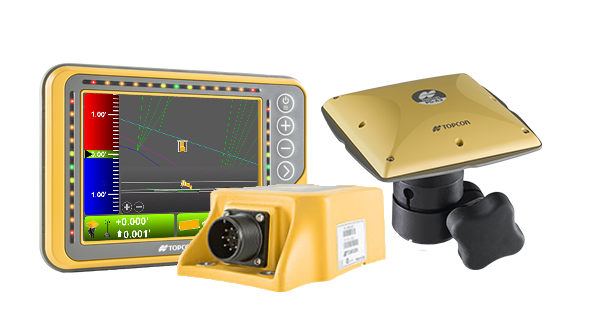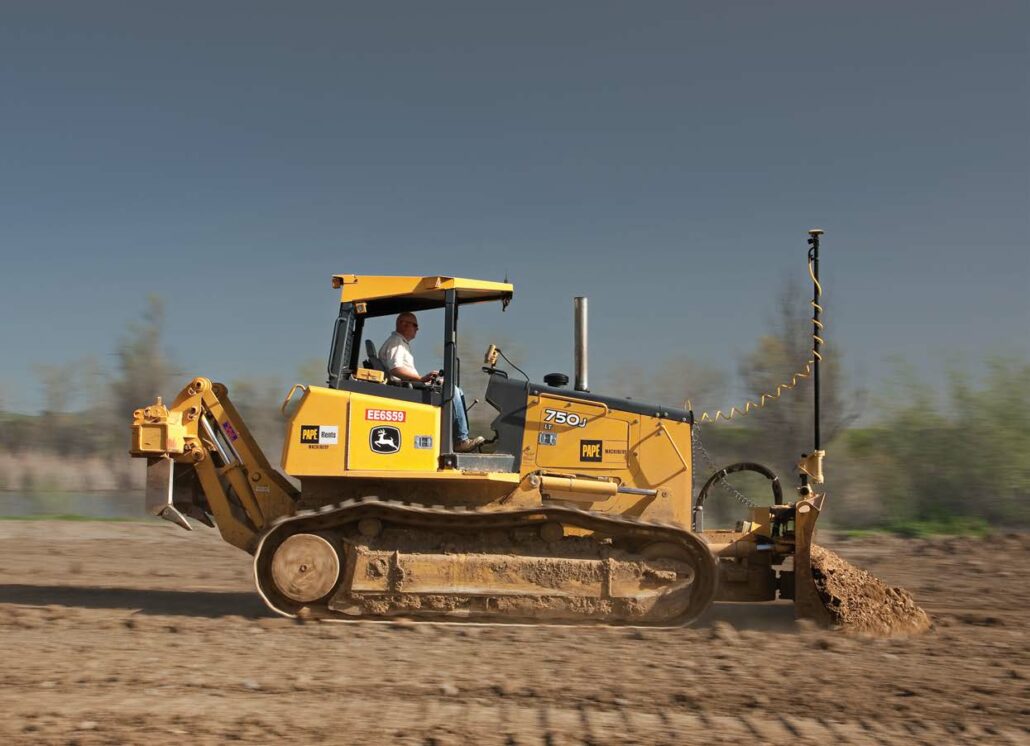While there has been plenty of attention in recent years on the productivity and performance advantages of the latest precision machine control technology in “high-end” construction projects and on large machinery, there are also huge benefits for smaller machines such as tractors and skidsteers.
These cover applications as diverse as house pads, general earthworks, sports grounds and industrial construction.
For the past 20 years, Aptella has been tailoring solutions for these smaller machines to meet the needs of customers around Australia.
One such innovation is a “laser-tractor” system for small agricultural tractors, incorporating Topcon machine-mounted lasers, custom-fit hydraulics and electrics, and a specially designed blade to enable precision grading on a small scale.
“Initially we manufactured a single tractor solution that we hired out, but as its popularity grew we began manufacturing them to suit the customer’s machine and requirements,” said Joel Seddon, national product manager for machine control at Aptella.
“They are a simple and ideal solution for smaller jobs like sports grounds, house pads, tennis courts and so on, or for use in tight spaces where you can’t get a grader in to do the work.”
And the great advantage of Topcon systems is that they are flexible to suit a specific job or application, while components can be swapped out or added to give a more accurate or appropriate solution as required.
Aptella also offers hire options across the product range, so if an owner-operator or contractor needs to meet a certain accuracy level for one job, they don’t have to invest in hardware they may not use on a regular basis.
This article looks at three contractors around Australia who are currently using various Topcon systems on smaller machines to increase their productivity, accuracy of operations, profitability and appeal to clients.

CASE STUDY 1: Peter Grzesik, Cranebrook Excavations, Sydney; running dual-grade Topcon lasers on laser-tractors, crawler loader, excavator
Grzesik and his son Rob operate about 15 items of equipment carrying out site preparation and levelling works for clients throughout the greater Sydney metropolitan area, as far west as the Blue Mountains and north to Newcastle.
Their equipment fleet – mainly Caterpillar – includes skidsteers, excavators, rollers, water carts and Aptella-modified John Deere 5320 laser-tractors fitted with mid-mounted grader blades, as well as four Topcon dual-grade lasers and three grade lasers able to be fitted across machines as required.
“Using these systems makes life a lot easier,” said Peter Grzesik.
“I usually rough the site out, then, because Rob is younger than me, he comes in and works all this modern technology. He sets it up, and it’s just magic.
“The builders, our clients, love these systems because when the job is finished, the quality is that close to a concrete surface in terms of smoothness.
“We have 15 pieces of gear, and we take what we need out to suit a particular job,” he said.
“On this project in Newcastle, which is being leased by a Chinese company to build coal trucks, we are preparing the subgrade and sitefall for the concreters.
“We’ve done the whole job from beginning to end using our Topcon equipment, starting with the main warehouse floor, which we set up to be dead level, and now we’re working on the carpark which has been graded with a slight pitch so the water can get away,” said Grzesik.
“We’ve been operating with this gear since it first came out.
“About 15 years ago, when I needed new equipment, the boys from Aptella, then known as Laserquip, showed me the Topcon range of equipment, and I’ve been buying it ever since.”
CASE STUDY 2: Shane Kelly, Terra Forma, Adelaide, running Topcon dual grade lasers and machine-mount laser systems on laser-tractors, graders and excavators
Terra Forma is a contracting company based Adelaide that specialises in industrial site preparation throughout Australia.
According to project manager Shane Kelly, its works include stormwater installations using laser systems on excavators, levelling for loading docks and outer pavements using both small and larger laser-equipped graders, and laser buggies for tight spaces and confined area work, which can run manually or automatically.
“What we find ideal about these laser-tractors with the Topcon systems on them is that, once the warehouse goes up, there are a lot of very tight corners,” said Kelly.
“We are able to get this machine out to the tighter corners, where you wouldn’t be able to get a grader into this situation.
“It cuts down on a lot of manual handling, whereas if you couldn’t get this machine in there, the guys have to do it all by hand – which is a slower process.
“We only have a small number of employees, which keeps things easier, so the more that we can do with the machine, obviously the quicker we can got the job done and then move on to the next project,” he said.
“We’re currently doing a project in Alice Springs where we’ve got a varying levels of heights in the building, with very small pads.
“Our little laser-tractors are ideal to do that and do setdowns and everything else. They were required on that job; we just couldn’t have done it with a grader,” Kelly said.
“With the Topcon laser systems fitted to them, they are a really easy machine to use.
“You don’t need a lot of training to be able to use one because it’s pretty simple stuff – and being a small company, we need all our employees to be able to operate pretty well everything
“Anyone who has used this, within about half an hour, they are an expert with it.
“When it comes to manual jobs, they need a bit better eye and we need a more experienced person, but in automatic we can put anyone on it and they have no problems,” he said.
CASE STUDY 3: Ash Beriman, McKinnon Earthmoving, Bendigo, running Cat 279C skidsteer fitted with Topcon 3D-MC2 system

McKinnon Earthmoving works predominantly in the Bendigo region, down as far as Macedon/Gisborne/Woodend to the north-west of Melbourne, carrying out a full range of subdivisional works, both residential and industrial.
Company owner Ash Beriman has opted to fit one of the most sophisticated machine control systems available, Topcon’s 3D-MC2 system, to a relatively inexpensive piece of equipment, a Cat 279C skidsteer.
The skidsteer is fitted with a single-antenna 3D-MC2 system, working off the machine’s 4:1 bucket, with the ability to work in two modes, either “bucket open” (as a dozing/grading blade) or “bucket closed” (as a conventional loader).
“We are using this set up for all our footpaths and curb and channel preparations on our subdivision projects,” he said.
“So, where in the past we have had a number of people preparing the curb bed and the footpath bed, with this skidsteer alone, we can put in the curb and channel, and the footpath bedding.
“The operator simply goes over and grabs material out of the pile, runs it out and cuts it all down to level.
“And once it finishes the footpath boxing, it then goes back and does all the topsoiling and cleanup after all they have put the footpath in, so it is pretty well non-stop getting around all the jobs.
“The system is more than paying for itself,” said Beriman.
“Something I’ve really tried to home in on is to cut out the amount of manual labour that is incorporated into civil construction and this has certainly let me do that.
“Traditionally, with a footpath, you would go along and box it all out, then you would have somebody tipping in all the rock, then you would have guys raking it out in between the boxing.
“It is all very slow and very labour-intensive; now with machine control on the skidsteer, the tolerances are that good that we have got it down to a 3 mm tolerance pretty much every time we work now.
“The operator can just go in ahead and put in all the bed material into the footpath before they box up behind him and then they are ready to pour.”
The skidsteer’s 4:1 bucket has a tilt hitch, allowing it to do cross-falls and elevation.
“Really, it’s just like a grader but on a much much smaller scale,” said Beriman. “But it still runs off the same design files and GPS signal.”

We source, deploy and support intelligent positioning solutions to enhance our customers’ productivity.
Aptella Pty Ltd
ABN 56 130 367 065
2024 Aptella Pty Ltd | ABN 56 130 367 065 | Terms and Conditions | Privacy Policy